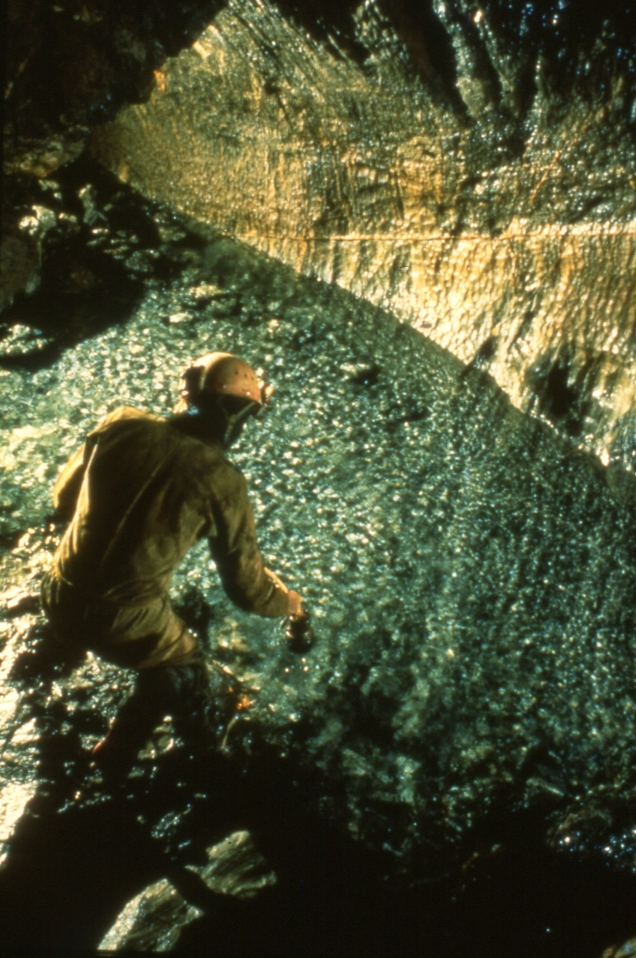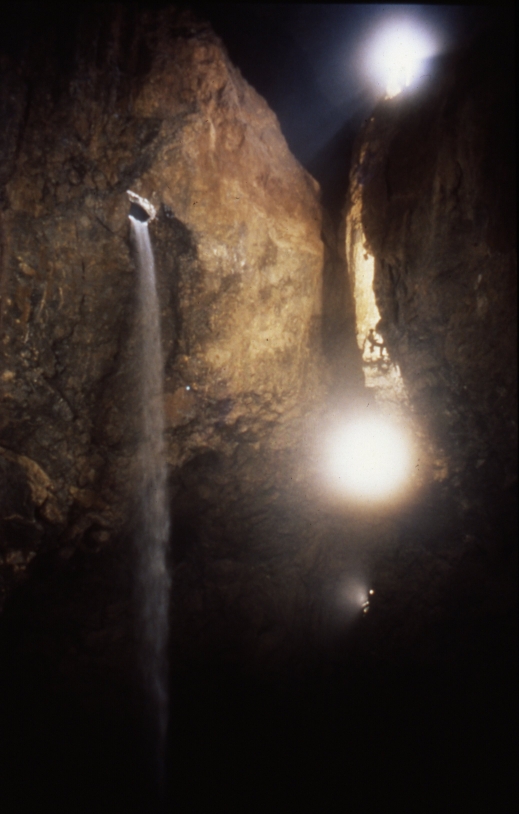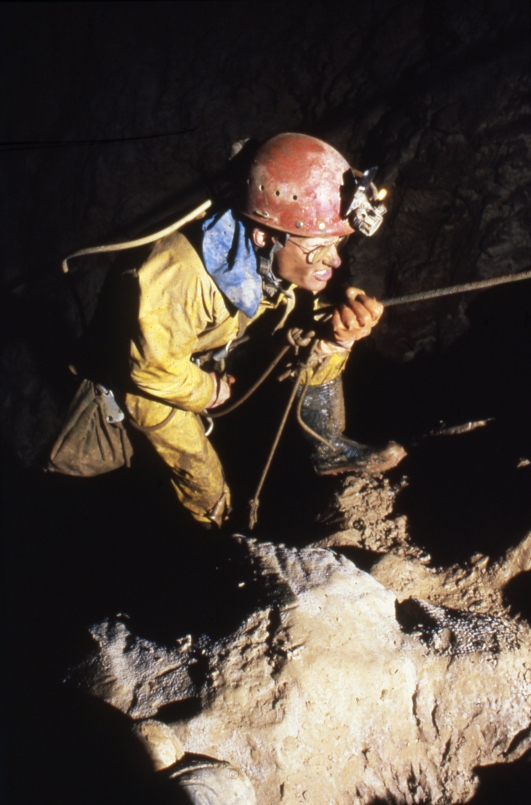
A good caving trip is a combination of all those things your mother
didn't like you doing when you were small - getting wet and dirty,
jumping off things, swinging about on ropes, wearing silly clothes,
singing and shouting... they often seem to end up in Pubs. Possibly
your mother might not approve of that either.
Maybe you've been in a "show cave". Led about by a guide
down some well-lit tunnel, to admire the sword of Damocles,
the Witch and so on. Beyond all this lies the real cave...
dark and mysterious, with formations far surpassing anything the
tourists see... where a river twists through sculpted rock walls
to plummet down a noisy waterfall. It's hill-walking with a lid
on, rock-scrambling in the dark, with a bit of Fantasia thrown in for
good measure.
Most importantly, caving isn't -or needn't be - difficult. You
don't need to be super-fit, learn esoteric techniques or pass
tests to start caving. You just need a bit of curiosity, some
basic gear and someone experienced to go with. Caving techniques,
such as they are, are best learnt down caves, not in a lecture
theatre. After a few trips, you'll be able to go to some of the
weirdest and most spectacular places in Britain - with confidence
and in safety.
Caverns measureless...
 We've
run overseas expeditions wher ewe have discovered,
explored and mapped some of the deepest caves ever found by
British clubs - including two caves over 1000m deep -
Pozu del Xitu (-1143 metres
- connected in 2010 to its resurgence cave by diving)
and
Pozo la Tormenta /
Asoploderu la Texa
(-1060m). OUCC has also discovered lots of new cave in Britain, including more than 20 km of spectacular cave passage in
Ogof Draenen, now Britain's 3rd longest cave system
(over 70km long!).
We are still in a golden age for cave exploration - where your
light can be the first, ever, to shine on that massive
cavern, that silent dark stream, (or, yes, that sordid muddy grovel).
We've
run overseas expeditions wher ewe have discovered,
explored and mapped some of the deepest caves ever found by
British clubs - including two caves over 1000m deep -
Pozu del Xitu (-1143 metres
- connected in 2010 to its resurgence cave by diving)
and
Pozo la Tormenta /
Asoploderu la Texa
(-1060m). OUCC has also discovered lots of new cave in Britain, including more than 20 km of spectacular cave passage in
Ogof Draenen, now Britain's 3rd longest cave system
(over 70km long!).
We are still in a golden age for cave exploration - where your
light can be the first, ever, to shine on that massive
cavern, that silent dark stream, (or, yes, that sordid muddy grovel).
But isn't caving dangerous ?
Statistically, caving is safer than diving, climbing, hang-gliding and probably
cycling around Oxford. One of the more noted northern cavers is
missing a leg. But it happened when he was run over by a tram
and, as he says, "there's no trams down caves". In other
words, the hazards in caves are natural, obvious and easily made safe.
Heavy rain can cause problems - but we keep a close eye on the
forecasts and avoid hazardous caves in dodgy weather.

Is it expensive ?
You don't have to buy any special gear to start with - we'll lend
it to you. If you get keen, you will soon want to buy your own set
of caving clothes (about £150-200). Maybe your own helmet and light (another
£150
for a good set.). That's it. Of course, gear
freaks can acquire all sorts of stuff, some of it useful.... If you go on
expedition, or get into vertical caving, you will need a set of clanking
aluminium gear that will get you up and down ropes. With the discounts we get,
about £300 will see you set up. Trip costs are at set prices to cover transport,
food and accommodation (£20-30 for day trips, around
£40 for long-distance weekends).
Membership of OUCC is £15-25 per year.Your first term's membership is included
in the cost of your first trip (see here for more
details about costs).
Will I enjoy it ?
The simple answer is, caving is so different to anything else,
you won't know till you try ! While those stuck in College at the weekend trawl through the library
for the last dog-eared copy of the works of Coleridge, you could
be heading down to your own sunless sea... a
real one.
How do I find out more?
All photographs are of caves discovered, explored, mapped and
photographed by OUCC. Click on the pictures for more details.



